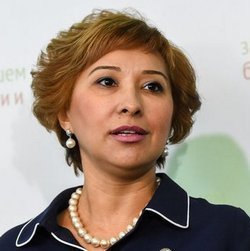Tatarstan ready to solve “digital problem” of TNV — the question in the feds
The republic asks Moscow to connect regional channels to the new format of TV via optical fiber, bypassing the third multiplex
On 14 October 2019, Tatarstan is transitioning from analogue broadcasting to digital. But three problems remain: poor families who do not have money to buy a set-top box or a satellite dish, settlements where there is no stable digital television signal (they are 157 in Tatarstan), and regional TV channels, including TNV, which did not get into the third multiplex. On 23 July, at the briefing in the Cabinet of Ministers, Tatatstan Minister of Communications Ayrat Khayrullin and Minister of Labour, Employment and Social Protection Elmira Zaripova told about the last stage of transition of Tatarstan from analogue broadcasting to digital, explained who exactly and what financial assistance from the republican budget can expect and how to watch TNV now.
When the transition from analogue television to digital will be
On 14 October 2019, 20 regions, including Tatarstan, are conducting a full-scale transition to digital television, in which analogue television will be cut off.
If the TV is analogue, you will have to purchase the appropriate console. DVB-T2 standard has been adopted as the main format of digital terrestrial television in Russia (this format must be supported by television). At the moment, digital terrestrial television broadcasting in Russia is conducted in a test mode: operational reliability of transmitting digital systems is being worked out, so there may be interruptions in the broadcast of digital television packages.
The digital package will include 20 TV channels: Channel One, Russia 1, Match, NTV, Channel Five, Russia-Culture, Russia 24, Karusel, OTR, TVC — this is the first multiplex (combining into a single digital package of TV channels in digital broadcasting, mixed, that is multiplexed before transmission on the transport channel). The second multiplex includes REN TV, Spas, STS, Domashny, TV3, Pyatnitsa, Zvezda, Mir, TNT, Muz-TV. The third multiplex is supposed to include local and regional TV channels.
Transition to digital television has been postponed both in Tatarstan and in Russia
It should be noted that the transition to digital television in Tatarstan was postponed twice. In August last year, Director of the branch of RTRS in Tatarstan Vladimir Yakimov said that, presumably, the shutdown of analogue broadcasting was planned for the beginning of 2019, but then it did not happen. Then it was announced at the federal level: February 11 — analogue broadcasting would be disabled in seven regions of the Russian Federation, April 15 — in 20 regions, June 3 — in all other regions of the country (including Tatarstan). But the plan was rewritten again, and Tatarstan entered the “third wave” along with 56 other regions, which were to switch to the digital television on June 3.
However, Tatarstan, apparently, is the only region that in June has not switched anywhere, Belgorod Oblast did it instead. The reason was the celebration of Eid al-Fitr on June 4, in connection with which the Tatarstan authorities asked to postpone the date — Tatarstan President Rustam Minnikhanov said that the digital transition should not cause serious inconvenience. However, Russia postponed the term. Initially, it was planned to cut off analogue broadcasting in the country in 2016, and due to the postponement to 2019, the budget lost 30 billion rubles: so much money was needed to subsidize analogue television in settlements where less than 100,000 people live.
Installation of collective antennas will be included in the overhaul programme
At the briefing on 23 July, recently appointed Minister of Information and Communication of Tatarstan Ayrat Khayrullin spoke about how the republic is going to help poor people of Tatarstan who do not have the necessary TVs and set-top boxes to switch to digital television on October 14, when analogue broadcasting will be cut off. First, from now on the programme of the overhaul of residential buildings should include mandatory installation and installation of a collective antenna (cost — 90,000 rubles per house). At the moment, more than 5,000 out of 12,000 houses are equipped with an antenna. The minister lamented the times when collective antennas were destroyed or “cut off for the sake of cable television”. Whereas, according to him, collective antennas allow to provide more qualitative and uninterrupted reception. As for the owners of TV models released earlier than 2012 (and unable to receive a digital signal), they will have to buy consoles.
“In Tatarstan, they are sold in 900 post offices, it is not necessary to go somewhere to buy. Yesterday, I was in Alekseevsky district, for example, there the consoles were sold and cost from 950 until 1,300 rubles. To explain how to connect, call hotline 8 800 220-20-02. In addition, volunteers will come to the house free of charge and set up digital broadcasting. Most importantly, the veterans, vulnerable, pensioners are not left out of the attention,” explained Khayrullin.
Whom the cost of consoles and satellite dish will be compensated for
The minister admitted that due to geographical reasons it is impossible to cover all 100% of the territory of Russia with digital television, and in Tatarstan too. There will be no stable digital signal in 157 settlements of the republic. However, 92% of the population of these points already use either IPTV or satellite dishes, and only 8% watch analogue TV. As a result, the Tatarstan authorities divided the task into two categories. First, it was decided that if a person connects satellite TV, 20 channels of them (federal package) will be for free. This solves the problem of the expensive construction of TV towers in each remote area.
The second decision of the republic: if a person lives in a territory where there is no reliable reception of broadcasting, and the person belongs to the category of socially vulnerable citizens, he or she is compensated for the cost of buying a console. “The work is done in manual mode.” Now the ministry is working closely with the lagging areas, they were not named, but cited as an example the words of one of the officials that “zero residents watch analogue television”:
“It's not possible. We will hold a videoconference with heads of districts. Sometimes their data does not correspond reality. People do not know about digital TV, they are not informed,” said the minister of communications.

Regional channels will get the possibility to broadcast on OTR
Today, up to 800,000 families live outside the digital reception zone in Russia (about 4,000 in Tatarstan). But there is also the zone of unstable reception of digital television, in Tatarstan there are about 24,000 people, or 0,6% of the total population. More than 99% of Tatarstan households had been covered by the first and second multiplexes already by June. Reception of digital terrestrial TV has been and remains difficult in 157 settlements of the republic, which are up to 12,500 households. At the moment, 600 people switch to digital television every day in Tatarstan, and it is necessary not less than 1000 so that 18,000 households had television on 15 October.
But there is another unsolved problem, which was voiced in December last year by Director General of the TV and radio company Tatarstan Novy Vek Ilshat Aminov: there are no regional channels in digital multiplexes, and not all residents have the opportunity to receive analogue terrestrial signal. Then he offered to broadcast regional TV on “the 22nd” button from cable TV operators. The Tatarstan minister of communications assured that antennas will receive both digital and analogue broadcasting:
“The issue of regional channels becoming part of the third multiplex has not yet been resolved. In 2020, it will not be resolved either. But in the autumn, on the Federal channel OTR in the regions there will appear the opportunity to carry out the insertion of 5-6 hours of the regional component in the morning and evening,” encouraged Ayrat Khayrullin. “It is not necessary to switch from digital to analogue and back. The set-top box is just a decoder decoding the digital signal. Analogue TV is received by default.”
Tatarstan could solve the “digital problem” of TNV
The minister explained that Tatarstan could solve its problem alone, which does not need the third multiplex (the 21st and 22nd of its “buttons” are saved for regional and municipal channels) and the launch of additional satellites: regional content can be produced in Kazan, packed and moved around the republic, TV towers will broadcast. Technically, it is possible. But the federal authorities have the authority to do so.
